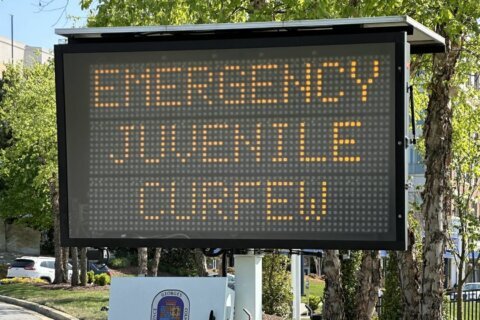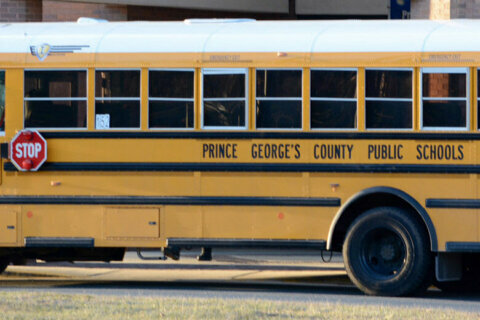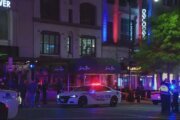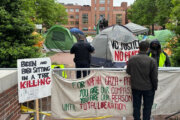For more than a year now, an archaeologist and a team of volunteers have been slowly and methodically combing through a wooded hillside in Bowie, Maryland.
They’re on a quest to document and provide a proper accounting for what was once thought to be dozens of unmarked graves — many of them containing the remains of African Americans, some of whom were enslaved on land that was once a Jesuit-owned plantation known as White Marsh.
But it turns out there weren’t just dozens of graves. There were hundreds.
Over the last year that number has gotten even bigger, and what was thought to be a search confined to an acre or two of land is now spanning eight acres with even more places to dig through in the years to come. Yes, years.
“Now along the hillside, we’ve mapped close to 600 potential grave markers,” said Dr. Laura Masur, an archaeologist and assistant professor of anthropology at Catholic University, who has overseen the efforts to identify unmarked graves on the grounds of Sacred Heart Catholic Church as well as other cemeteries once owned by the Jesuits.
Masur said she anticipates there are perhaps 100 to 200 more grave markers along the hillside where the team has been concentrating its efforts.
“So we’re probably looking at somewhere in the order of about 800 unmarked graves in this area,” she added.
The hillside, visible from Maryland Route 450/Annapolis Road, is now covered with tiny pink and orange flags, each marking a grave site. The hillside is adjacent to a cemetery — with some graves dating back centuries — that’s been well-maintained over the years. There are about 800 grave stones there, though some mark the resting place of entire families, rather than individuals.
Along the hilly stretch of land, Masur has been digitally mapping every rock and presumed grave site into an electronic database, adding names when she can. In many cases it hasn’t been possible.
“It’s a really challenging thing to piece out when you have an unmarked grave. Is it a marker of poverty? Is it a marker of race? Could it be both? And that’s one of the big questions that we’ve been puzzling over,” she said.
Based on historical records and other documents, Masur has identified about 2,100 burials as having taken place on the hillside near the cemetery on what once was the White Marsh tobacco plantation.
“About 700 of them are probably African American, but we only know the locations of perhaps about a dozen of those African American graves — so that’s where we can link an individual’s name and inscription,” Masur said. In part, that’s done by referencing a list of common surnames of known African Americans buried at White Marsh.
“But most of the African Americans we have recorded as being buried between maybe the 1850s and the 1930s, we don’t know where they’re buried,” Masur said. “So we presume those are predominantly the burials that are along the hillside.”
She added that “the way it looks is, it’s a very active cemetery in the 19th and early 20th century, and then it declines.” That was in the 1930s.
Then in the late 1960s, when Sacred Heart parish was founded, more burials started to fill up the cemetery once again.
Still, there are frustrating gaps in the historical record.
Despite exhaustive searches from descendants and parishioners, there are no documented deaths before the year 1819, and Masur estimates that there are probably several hundred more people from that time period buried on the property.
‘It was no longer someone else’s story’
These days, it’s not just the earth on that wooded hillside that’s being searched for clues.
Descendants of those who lived and worked on the land decades, if not centuries, ago have started up a nonprofit called the White Marsh Historical Society to help scour through family trees, tax records, death records and other genealogical records to try to determine who might be buried there.
Much of the work is done by people living locally, but it has become a nationwide effort with some now scattered far across the country trying to unearth the mysteries of the land and their ancestors who were laid to rest there.
A year ago, the group started with a few dozen names of those buried at White Marsh. Now, they know the names of about 700 people who, according to death records and genealogical materials, were buried there.
It’s been an eye-opening experience for Denise Barton, a Georgetown University graduate who grew up in Pennsylvania and now lives in Ann Arbor, Michigan. She remembers visiting Bowie for family reunions, never knowing the connections she had to the land.
“I’ve experienced the full range of emotion,” Barton said. “Once I found out, I actually ordered the early records of White Marsh from the Prince George’s County Genealogical Society … and I turned to a page and decided just to go line by line to see if any relatives’ names were on there. And when I saw the names of my great-grandparents and my great-great-grandparents and that they were baptized there — it leapt off the page. So it was no longer someone else’s story. It was then my story.”
In the fall of 2022, before much was known about the property, Barton said she inadvertently walked right past the tombstone of her great-great-grandfather, Francis Johnson, without even knowing it. When she went online and saw his burial site, she said “it just hit me like a ton of bricks.”
The list of names that could unearth hidden history

In fact, throughout the last year, the White Marsh Historical Society has been working to connect with as many descendants as possible. They’re spread out all across the country, though significant numbers live around St. Louis, Louisiana and Philadelphia — places where ancestors were sold centuries ago. Many, however, still live in the D.C. area — with no clue that their ancestors’ final resting place is so close by.
“People are shocked. They’re really amazed and it takes a while to absorb it all,” said Lynn Nehemiah, the vice president of the historical society. “They’re totally blown away. People are excited to know that they are connected to an important part of American history. But at the same time, they’re saddened to hear it — to know that they have personal connections to those who were enslaved. You know it, but to know it at a deeper level in terms of knowing names.”
The effort to uncover names and rediscover missing links in family trees is what Kevin Porter, the president of the White Marsh Historical Society, calls “reparative research.”
“It’s unfortunate that a lot of information has been lost through time,” said Porter, whose ancestors are buried at White Marsh. “A lot of the history has been lost, too. And a lot of the reparative research that we’re trying to do is to identify as many names as possible, connect those individuals that are buried here to the family networks throughout this area. A lot of the families are connected, not only to the people that were enslaved here, but to the neighboring families — prominent families, such as the Bowie family, the Carroll family.”
Now, the group has a long list of surnames — some with multiple spellings — who they reach out to in order to connect. An event at Holy Family Catholic Church in Mitchellville, Maryland, just a few miles away, led to even more connections.
Honoring the dead
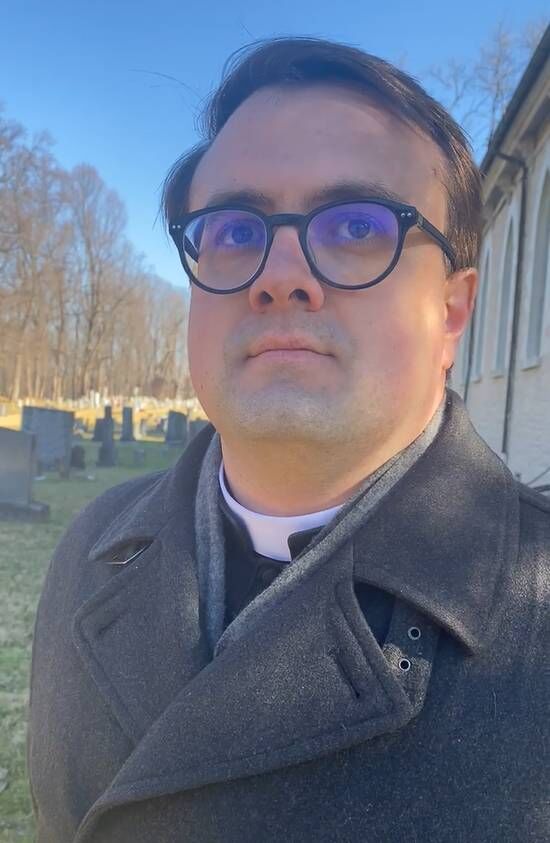
The list of names just keeps growing. The amount of work not just for Masur, but for all those who volunteer on various committees, also keeps growing.
“A year later, we’re still in the discovery phase,” said Rev. Michael Russo, a priest at Sacred Heart. “We’re still in this very intense research phase of trying to understand how big this burial ground is, how big the connections of the descendant community are and what more work we need to do.”
In many cases, those who might have to reckon with the more shameful side of history might be reluctant to get involved. But that hasn’t been the case at Sacred Heart.
“We’ve discovered more people that are part of the Communion of saints,” said Rob Hayes, a parishioner, using the term from the Catholic doctrine to describe the fellowship between Christians, both living and the dead.
Hayes helps lead what is known as the Cemetery Committee at the church.
“We didn’t know they were there,” he said. “There may have been records that are long gone, but now that we’ve discovered them, we’ve discovered the graves, and so it’s really our duty and our privilege to honor them.”
Honoring the dead, he pointed out, is one of the “corporal works of mercy,” alongside feeding the hungry and clothing the naked.
Call for volunteers

Back on Nov. 1, which is All Saints Day in the church, hundreds of candles were lit and placed on each grave marker along the hillside. And throughout the last year, hundreds of people — parishioners, descendants, and the public at large — have put in thousands of combined hours to help clean up and reduce decades of overgrowth that nearly swallowed up the forgotten history on the hillside.
This Monday, the public is invited to do it again. Crews will be working from 10 a.m. to 3 p.m. to remove fallen tree limbs, rake up leaves and debris, and do other landscaping work.
A parish that has long embraced its colonial roots is also acknowledging the indignities that occurred there.
“It’s not a comfortable part of the history, but it is part of the history,” said Hayes. “There’s research to be done, there are things to find and preserve that history, and tell the broader story of the people that lived there, worshipped there, died there — both the enslaved as well as the others. We don’t know yet what we’re going to find because there’s a lot of history we have not uncovered. And so we’re going do our best to pursue that and tell the broader story.”
That willingness to help is so important to those who can trace their ancestors back to that hillside.
“We need their help. They have a lot of history about the property that we wouldn’t otherwise have,” said Crystal Queen, a cousin of Kevin Porter, who also lived much of her life not knowing about her family’s history. “It’s been refreshing that they’ve been willing to work with us on this cemetery project and uncovering more of our history. In some other places, that hasn’t been the case. So we’re definitely appreciative of that.”
Facing challenges
But a story that old will take a lot of time to write and tell. And erosion on the hillside remains a concern, especially as brush and other forms of vegetation are removed. That has the potential to disturb even more grave sites than have already been impacted by erosion there. For now, those involved in uncovering the history are focusing on about eight acres of land, even though there’s strong belief that the cemetery wraps further around the hillside.
Mother Nature has posed challenges in other ways, too. Every time a big rainstorm hits — such as the major downpours across the D.C. region Tuesday — even more stones are unearthed on the hillside. It’s not certain that every stone marks a grave site, but Masur said the location certainly makes it possible.
“One of the biggest challenges of the project is finding ways to get an accurate total number,” acknowledged Masur. “I think we’ll get as close as we can.”
At the moment, the number of names doesn’t match the number of stones around the property. And sometimes a stone is just that, a stone.
“So it’s going to keep going, it’s going to keep growing,” said Rev. Russo. “But the important thing is we want, as much as possible, the whole story to be known and to be told.”
“Sometimes it’s hard because everyone wants immediate results,” Masur said. “And everyone wants a clear resolution to a project when, in reality, this takes multiple years and a lot of difficult discussions to actually get a sense of closure for a project.”
Those who are involved in the effort have been applying for grant money to help maintain and preserve the land. Meanwhile, Masur, who is due to give birth in a month, continues to try to record as much data about the land as possible, knowing all the final answers and conclusions everyone wants might not be attainable.
Other smaller projects elsewhere have taken decades. This effort has been underway for about a year.
Eventually, when the database is complete, it’ll be made public and will provide the acknowledgment that many of those buried there never got. It won’t be precise, it won’t be perfect, but it will be a major step toward reclaiming and resurrecting a history that once was all but lost.
“Our goal is in looking at the historical information. If we have a record that someone is buried here and we have a record of a burial that is unmarked, then we can say, ‘these are the names of the people who could be buried here,'” Masur said. “And we can sort of have a digital map saying, ‘perhaps for these 800 people, these 800 names we have, this is where they’re buried.’ We don’t know where each individual person is buried. But we know that they’re buried in this area. And it’s the best we can do at this point.”
And that’s why she keeps walking, mapping each stone on a tablet and recording history, inspired by the support she’s gotten so far from everyone involved — the church, the Archdiocese of Washington, bishops from around the country and those whose ancestors were once forgotten.
“We’re working to try and make sure that we have as many records as we can, and that we find a way to make those available to the community so that people can come here and … visit the graves of their loved ones,” she said.
Get breaking news and daily headlines delivered to your email inbox by signing up here.
© 2024 WTOP. All Rights Reserved. This website is not intended for users located within the European Economic Area.


